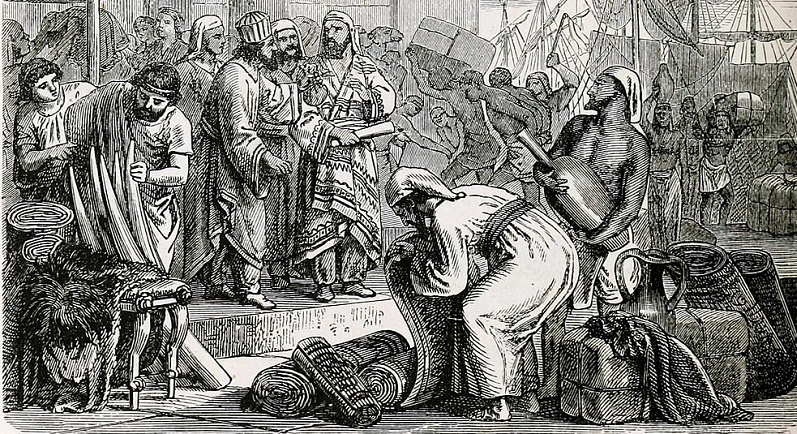
In an era where digital transformation dominates every aspect of business, it’s easy to assume that modern challenges require exclusively modern solutions. However, as we navigate the complexities of global markets and digital landscapes, there is profound wisdom to be gleaned from the past. From the personal connections that underpinned ancient trade routes to the art of storytelling that brought marketplaces to life, these practices have survived centuries for a reason. They resonate with fundamental aspects of human nature and commerce that remain relevant, even in our technology-driven age.
Contents
The Value of Personal Connections
In a world where digital interactions often replace face-to-face connections, it’s easy to overlook the importance of personal relationships in business. Yet, history tells us that the strongest commercial endeavors have always been built on a foundation of trust and personal rapport.
Ancient Trade and Personal Relationships
Trade in ancient times was far more than just a transaction; it was a personal affair. Merchants knew their customers and their families, often creating bonds that lasted generations. These relationships were not just beneficial for business; they were its very lifeblood. This deep sense of connection and trust was crucial for trade routes spanning vast distances, where a merchant’s reputation was their most valuable asset.
Building Trust in the Digital Age
Today, the essence of trust in business remains unchanged, but the methods of building it have evolved. In the digital world, trust is often established through online reviews, social media interactions, and the transparency of digital communication. Yet, these digital tools can be used to foster a sense of personal connection reminiscent of ancient times. Businesses that succeed in creating a personal touch through their digital platforms often see increased customer loyalty and engagement.
For instance, personalized marketing efforts using data analytics can create a feeling of individual attention in the digital space. Similarly, engaging with customers through social media, responding to their comments, and addressing their concerns personally can recreate the ancient market’s sense of community and belonging.
Case Studies of Successful Relationship-Driven Digital Businesses
Numerous modern businesses have harnessed the power of personal connections in the digital realm. A notable example is an online retailer that personalizes user experience by remembering past purchases and suggesting new products based on individual preferences. Another example is a social media platform that has built a community where businesses and consumers interact directly, allowing for a more personal relationship than traditional advertising avenues.
These case studies demonstrate that even in an age dominated by technology, the ancient practice of building personal connections remains a cornerstone of successful business. They show how digital tools can be used to foster relationships that are not just transactional but also personal and enduring [1].
The Art of Storytelling in Business
Storytelling has always been a pivotal element in human communication, and its role in business is no less significant. In ancient times, stories were not just a form of entertainment; they were powerful tools for merchants to connect with their customers and stand out in bustling marketplaces. Today, in the digital era, storytelling remains an essential strategy for businesses to engage and resonate with their audience.
Storytelling in Ancient Marketplaces
In the markets of old, storytelling was a way to attract and retain customer attention. Merchants would share tales of where their products came from, the people who made them, or the unique qualities they possessed. These stories did more than just describe a product; they created an emotional connection with the audience, making the purchasing experience memorable and personal. A rug was not just a piece of fabric; it was a tapestry of cultural heritage and craftsmanship. A spice was not just a flavoring; it was an exotic journey to faraway lands.
Brand Narratives in Today’s Online Markets
In the digital age, storytelling has taken on new dimensions. Brands now have the opportunity to tell their stories across various platforms, reaching a global audience. The narrative is no longer just about the product but about the brand’s values, mission, and the people behind it. Effective storytelling in digital marketing doesn’t just sell a product; it builds a brand identity.
Digital storytelling is about creating a narrative that consumers can identify with. It could be the story of how a company was founded, the challenges it overcame, or how its products are making a difference in people’s lives. These narratives help to humanize brands, making them more relatable and trustworthy to consumers.
Examples of Effective Digital Storytelling
There are many success stories of brands that have mastered digital storytelling. One notable example is a lifestyle brand that shares customer stories and experiences on its website and social media, connecting its products to real-life moments and emotions. Another example is a tech company that frequently shares behind-the-scenes content, showcasing its team and the innovation process, thus creating a narrative of cutting-edge technology blended with human ingenuity.
These examples demonstrate that the ancient art of storytelling is as relevant today as it was in the past. By weaving compelling narratives, businesses can create a strong emotional connection with their audience, making their brand and products more appealing and memorable in the competitive digital marketplace [2].

Barter and Trade: Adapting Ancient Economic Models
The concept of barter and trade, foundational to ancient economies, holds valuable lessons for modern businesses, especially in an era increasingly focused on sustainability and alternative economic models. This ancient practice, where goods and services were exchanged directly without the use of money, exemplifies the simplicity and directness of economic transactions. In today’s digital world, these concepts are finding new relevance and applications.
Historical Perspective on Barter Systems
Barter systems have been the backbone of economic exchange for millennia, long before the invention of currency. These systems were based on the direct exchange of goods and services, relying on mutual needs and trust between parties. In ancient times, a farmer might trade grain for tools, or a potter might exchange ceramics for cloth. This system required a deep understanding of the value of different goods and services and fostered a sense of community and cooperation, as each trade was a personal interaction.
Modern Applications of Trade and Exchange
In the digital age, the concept of barter has evolved but its essence remains. Modern businesses are rediscovering the benefits of direct exchange systems, facilitated by technology. Digital platforms now allow for the efficient matching of goods and services, enabling businesses and individuals to trade without the need for cash transactions. This not only promotes sustainability by reducing the need for new production but also fosters a sense of community and mutual support reminiscent of ancient trade practices.
Furthermore, in an era where sustainability and resource management are paramount, barter systems offer an alternative to the traditional cash economy, emphasizing the reuse and recycling of resources. Digital bartering platforms have made it easier for businesses to exchange surplus goods and services, minimizing waste and maximizing resource utilization.
Innovative Digital Platforms Embracing Barter
Several innovative digital platforms have successfully adapted the barter system for the modern era. For instance, there are online marketplaces where businesses can exchange services like web design for marketing support, replicating the ancient practice of barter in a digital context. Another example is a platform that allows companies to trade excess inventory or unused office space with other businesses, creating a sustainable ecosystem of resource sharing [3].
These platforms are not only practical solutions for resource management and cost savings but also encourage a sense of community and collaboration among businesses. They echo the ancient practice of barter, proving that some economic principles are timeless and can be adapted to suit the needs of the modern world.
Sustainable Practices and Long-Term Vision
Sustainability and a long-term vision were integral to many ancient business practices, often borne out of necessity and respect for limited resources. These principles, focused on maintaining balance and ensuring continuity, are increasingly relevant in today’s business world, where sustainability is not just a moral imperative but also a key to long-term success.
Ancient Sustainability and Resource Management
In ancient times, businesses were closely tied to the natural environment, and resource management was crucial. Farmers, artisans, and traders all understood the importance of sustainable practices. They used resources judiciously, recycled materials, and often had a deep understanding of ecological balance. This approach was not only environmentally responsible but also ensured that their businesses could thrive over the long term, preserving resources for future generations.
Incorporating Sustainability into Modern Business Models
Modern businesses are increasingly recognizing the importance of sustainability. This includes not just environmental responsibility, but also a broader vision that considers the long-term impact of business activities on society and the planet. Companies are now adopting strategies that minimize waste, use resources efficiently, and prioritize the wellbeing of communities and the environment.
This shift towards sustainability is evident in various practices, such as the use of renewable energy, sustainable sourcing of materials, and the implementation of recycling programs. Moreover, businesses are realizing that sustainable practices can lead to cost savings, improved brand reputation, and better long-term prospects [4].
Profiles of Sustainable Digital Enterprises
There are numerous examples of digital enterprises that have embraced sustainability as a core business principle. For instance, an online retailer has implemented a fully sustainable supply chain, sourcing products from eco-friendly manufacturers and using biodegradable packaging. Another example is a tech company that has significantly reduced its carbon footprint by optimizing its data centers for energy efficiency and investing in renewable energy sources.
These companies are not just minimizing their environmental impact; they are also setting new standards for their industries. Their commitment to sustainability demonstrates how modern businesses can learn from ancient practices, ensuring not only their own longevity but also contributing to a healthier, more balanced world.

Mentorship and Knowledge Transfer
Mentorship and the transfer of knowledge have been crucial aspects of business practices since ancient times. These traditions, built on the sharing of experience and wisdom from one generation to the next, have shaped the skills, values, and success of business communities. In the digital era, these practices continue to play a vital role, adapting to new technologies and communication methods.
Traditional Mentorship Roles in Ancient Commerce
In ancient commerce, the role of a mentor was often filled by a master craftsman, seasoned trader, or elder in the community. Apprenticeships were common, where young learners would work closely with experienced professionals, gaining hands-on experience and learning the intricacies of their trade. This mentorship was not just about skill acquisition; it also involved instilling values, ethics, and a deep understanding of the business and social environment.
Modern Mentorship and Coaching in the Business World
Today, mentorship has taken on new forms but its essence remains the same. In the contemporary business world, mentorship programs, both formal and informal, are key for professional development and growth. Experienced professionals guide newer employees, offering insights, advice, and support. This transfer of knowledge is critical in a rapidly changing business landscape, where new skills and perspectives are constantly required.
The digital era has expanded the scope of mentorship. Virtual mentorship programs, online coaching sessions, and digital platforms for knowledge sharing have become increasingly popular. These tools allow for a broader reach, enabling mentors and mentees to connect regardless of geographical boundaries.
Online Platforms Facilitating Mentorship
There are numerous digital platforms that have successfully facilitated mentorship and knowledge transfer. For instance, online professional networks allow seasoned professionals to share their insights with a wider audience, offering advice and guidance to those at the start of their careers. Another example is a platform that pairs aspiring entrepreneurs with experienced business leaders, providing valuable mentorship in starting and growing a business.
These platforms demonstrate the continued importance of mentorship in the business world. They provide opportunities for learning and development that are essential for personal growth and the advancement of businesses. By embracing digital tools, modern mentorship can maintain the spirit of ancient knowledge transfer practices while reaching a wider and more diverse audience [5].
Balancing Profit and Community Welfare
The balance between pursuing profit and ensuring the welfare of the community has been a consideration in business practices for centuries. Ancient enterprises often thrived by aligning their interests with the well-being of their communities, understanding that long-term success was tied to mutual prosperity. In the contemporary business landscape, this balance is more relevant than ever, with companies recognizing the importance of social responsibility alongside profitability.
Community-Centric Business Models in History
Historically, many businesses were deeply integrated into their local communities. They provided goods and services that were essential to daily life, and in return, the community supported these businesses. This symbiotic relationship meant that the success of a business was directly linked to the health and prosperity of its community. Such businesses often played a role in community events, contributed to local causes, and were seen as pillars of society.
The Rise of Social Entrepreneurship in the Digital Age
In today’s digital age, the concept of social entrepreneurship has taken this ancient principle to a new level. Social entrepreneurs use business as a tool to solve social problems, combining profitability with a mission to positively impact society. This approach reflects a growing awareness among consumers and businesses alike of the importance of ethical, sustainable, and community-focused practices.
The digital world has also made it easier for businesses to engage with communities, whether through social media, online fundraising, or through the creation of platforms that directly address social issues. Companies are increasingly held accountable by their customers and the public, and those that successfully balance profit with community welfare often enjoy greater loyalty and trust.
Impactful Businesses Blending Profit and Social Good
Numerous modern businesses exemplify this balance. For example, a company that donates a portion of every sale to local education initiatives, directly linking its business success to community development. Another example is an online platform that connects skilled professionals with non-profit organizations, facilitating pro-bono work that supports community projects.
These businesses demonstrate that profitability and social responsibility can go hand in hand. By adopting a community-centric approach, they are not only contributing to societal well-being but also building sustainable, respected, and profitable enterprises.
References
[1] Reviving Ancient Wisdom: Indigenous Knowledge Entrepreneurs Pave the Way
[2] Reviving Centuries-Old Wisdom: Exploring Arbitrage as a Cornerstone of Modern Investment in the Digital Era
[3] Why Marketers Are Returning to Traditional Advertising
[4] Restoring and attributing ancient texts using deep neural networks
[5] How ancient traditions extend their reach via digital transformation
